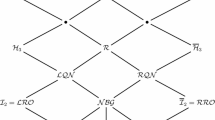Abstract
We consider various aspects of the Segre variety \({\mathcal{S}:=\mathcal{S} _{1,1,1}(2)}\) in PG(7, 2), whose stabilizer group \({\mathcal{G}_{\mathcal{S}}<{\rm GL}(8,2)}\) has the structure \({\mathcal{N}\rtimes{\rm Sym}(3),}\) where \({\mathcal{N} :={\rm GL}(2,2)\times{\rm GL}(2,2)\times{\rm GL} (2,2).}\) In particular we prove that \({\mathcal{S}}\) determines a distinguished Z 3-subgroup \({\mathcal{Z}<{\rm GL}(8,2)}\) such that \({A\mathcal{Z}A^{-1}=\mathcal{Z},}\) for all \({A\in\mathcal{G}_{\mathcal{S}},}\) and in consequence \({\mathcal{S}}\) determines a \({\mathcal{G}_{\mathcal{S}}}\)-invariant spread of 85 lines in PG(7, 2). Furthermore we see that Segre varieties \({\mathcal{S}_{1,1,1}(2)}\) in PG(7, 2) come along in triplets \({\{\mathcal{S},\mathcal{S}^{\prime},\mathcal{S}^{\prime\prime}\}}\) which share the same distinguished Z 3-subgroup \({\mathcal{Z}<{\rm GL}(8,2).}\) We conclude by determining all fifteen \({\mathcal{G}_{\mathcal{S}}}\)-invariant polynomial functions on PG(7, 2) which have degree < 8, and their relation to the five \({\mathcal{G}_{\mathcal{S}}}\)-orbits of points in PG(7, 2).
Similar content being viewed by others
References
Bosma W., Cannon J., Playoust C.: The MAGMA algebra system I: The user language. J. Symbol. Comput. 24, 235–265 (1997)
Burau W.: Mehrdimensionale projektive und höhere Geometrie. Dt. Verlag d. Wissenschaften, Berlin (1961)
Conway J.H., Curtis R.T., Norton S.P., Parker R.A., Wilson R.A.: Atlas of Finite Groups. Clarendon Press, Oxford (1985)
Glynn D.G., Gulliver T.A., Maks J.G., Gupta M.K.: The Geometry of Additive Quantum Codes. Available online: www.maths.adelaide.edu.au/rey.casse/DavidGlynn/QMonoDraft.pdf (2006).
Green R.M., Saniga M.: The Veldkamp space of the smallest slim dense near hexagon, preprint, arXiv:0908.0989
Havlicek H., Odehnal B., Saniga M.: Factor-group-generated polar spaces and (multi-)qudits. SIGMA Symmetry Integr. Geom. Methods Appl., 5, paper 096, 15 pp (electronic) (2009).
Havlicek H., Odehnal B., Saniga M.: On invariant notions of Segre varieties in binary projective spaces, submitted to Des. Codes Cryptogr.
Hirschfeld J.W.P., Thas J.A.: General Galois Geometries. Oxford University Press, Oxford (1991)
Lévay P., Saniga M., Vrana P.: Three-qubit operators, the split Cayley hexagon of order two and black holes. Phys. Rev. D 78, 124022 (2008)
Lévay P., Saniga M., Vrana P., Pracna P.: Black hole entropy and finite geometry. Phys. Rev. D 79, 084036 (2009)
Shaw R.: Linear Algebra and Group Representations, vol. 2. Academic Press, London (1983)
Shaw R., Gordon N.A.: The polynomial degree of the Grassmannian \({\mathcal{G}_{1,n,2}}\). Des. Codes Cryptogr. 39, 289–306 (2006)
Shaw R.: The psi-associate X # of a flat X in PG(n, 2). Des. Codes Cryptogr. 45, 229–246 (2007)
Shaw R.: The polynomial degree of Grassmann and Segre varieties over GF(2). Discret. Math. 308, 872–879 (2008)
Author information
Authors and Affiliations
Corresponding author
Additional information
Communicated by G. Lunardon.
Rights and permissions
About this article
Cite this article
Shaw, R., Gordon, N. & Havlicek, H. Aspects of the Segre variety \({\mathcal{S}_{1,1,1}(2)}\) . Des. Codes Cryptogr. 62, 225–239 (2012). https://doi.org/10.1007/s10623-011-9508-y
Received:
Revised:
Accepted:
Published:
Issue Date:
DOI: https://doi.org/10.1007/s10623-011-9508-y




